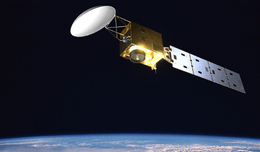EarthCARE
 Artist's view of EarthCARE | |
| Mission type | Earth observation |
|---|---|
| Operator | ESA/JAXA/NICT |
| Website |
EarthCare on esa |
| Mission duration | 2 years (planned) |
| Spacecraft properties | |
| Bus | AstroBus-L |
| Manufacturer | EADS Astrium |
| Launch mass | ~ 2,000 kilograms (4,400 lb) |
| Dimensions | 2.5 by 19 metres (8.2 ft × 62.3 ft) |
| Power | ~ 2500 watts |
| Start of mission | |
| Launch date | 2018[1] |
| Rocket | Soyuz ST-B/Fregat-MT (planned) |
| Launch site | Kourou ELS |
| Contractor |
Arianespace Starsem |
| Orbital parameters | |
| Reference system | Geocentric |
| Regime | Sun-synchronous |
| Perigee | 393 kilometres (244 mi) |
| Apogee | 393 kilometres (244 mi) |
| Inclination | 97 degrees |
| Period | 92 minutes |
| Repeat interval | 25 days |
| Epoch | Planned |
| Transponders | |
| Band |
S Band (TT&C support) X Band (science data acquisition) |
| Bandwidth |
2 Mbit/s download (S Band) 150 Mbit/s download (X Band) 64kbit/s upload (S Band) |
| Instruments | |
|
ATLID: ATmospheric LIDar CPR: Cloud Profiling Radar MSI: Multi-Spectral Imager BBR: BroadBand Radiometer | |
 Living Planet Programme | |
EarthCARE is a planned joint European/Japanese (ESA/JAXA/NICT) satellite, the sixth of ESA's Living Planet Programme. The main goal of the mission is the observation and characterization of clouds and aerosols as well as measuring the reflected solar radiation and the infrared radiation emitted from Earth's surface.[2][3]
History
In May 2008 ESA signed a contract worth €263 million (£220 million/$360 million) with EADS subsidiary Astrium. As the prime contractor, Astrium is responsible for the satellite's design, development and integration.[4] Design and construction began in early 2009 while launch is due for 2016.[5] EarthCARE is an acronym standing for Earth Clouds, Aerosols and Radiation Explorer, and the aims of the mission are to improve understanding of the cloud, radiative and aerosol processes that affect the Earth's climate.[6] As of January 2011, the total budget for the project is £500 million (€590 million/$810 million).[5] A significant proportion of the project will be manufactured in the UK, the main structure of the spacecraft will be built by RUAG Space in Switzerland and subsequently completed in Astrium's Stevenage facility, while one of the instruments will be made in Sevenoaks by SSTL and another in Bristol, Somerset by SEA Group Ltd, now part of Thales Alenia Space UK.[5] In September 2014 ESA and JAXA held a joined EarthCARE International Science Workshop.[7] From 2014 to 2015 an ongoing integration of the instruments takes place.[7] In 2015 launch was postponed to 2018 due to problems with Lidar development.[1]
Science
The satellite will make measurements useful for better understanding the Earth's thermal and solar radiation balance. In particular, a combination of active (lidar and radar) and passive (radiometers and imagers) instruments will enable EarthCARE to simultaneously measure the vertical and horizontal distribution of clouds and atmospheric aerosols along with Top-Of-Atmosphere (TOA) Long- and Short-wave fluxes.
The spacecraft will feature four distinct instruments:
- Backscatter Lidar (ATLID) - ESA High-spectral resolution and depolarisation
- Cloud Profiling Radar (CPR) - JAXA/NICT -36 dBZ sensitivity, 500 m vertical resolution, Doppler
- Multi-Spectral Imager (MSI) - ESA 7 channels, 150 km swath, 500 m pixel
- Broadband Radiometer (BBR) - ESA 2 channels, 3 views (nadir, fore and aft). A broadband Radiometer.
See also
External links
- EarthCARE page on ESA website
- EarthCARE on ESA eoPortal
- EarthCARE page on JAXA website
- EarthCARE on JAXA Earth Observation Research Center
- Earth Care Awards (ECAs)
References
- 1 2 de Selding, Peter B. (22 May 2015). "Cost, Schedule Woes on 2 Lidar Missions Push ESA To Change Contract Procedures". Spacenews. Retrieved 4 June 2015.
- ↑ "EarthCARE". ESA's EarthNet Online. Retrieved 2013-10-30.
- ↑ "EarthCARE (Earth Clouds, Aerosols and Radiation Explorer)". ESA's eoPortal. Retrieved 2013-10-30.
- ↑ "EarthCARE satellite contract signed". ESA. 27 May 2008. Retrieved 30 May 2015.
- 1 2 3 "Europe's Earthcare space laser mission gets go ahead". BBC. 18 February 2011. Retrieved 30 May 2015.
- ↑ "ESA's cloud, aerosol and radiation mission". ESA. 19 February 2013. Retrieved 30 May 2015.
- 1 2 "ESA Bulletin 161 (1st quarter 2015)" (PDF). ESA. 2015. p. 70. ISSN 0376-4265. Retrieved 30 May 2015.